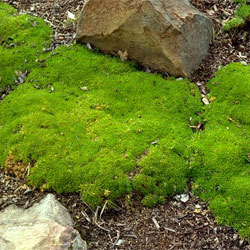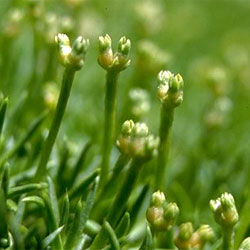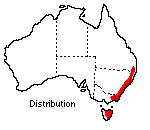Scleranthus biflorus
 |
 |
Two flowered Knawel
Scleranthus biflorus (J.R.Forst. & G.Forst.) Hook.f.
Scleranthus is a small genus in the Caryophyllaceae family, a family that includes the exotic carnations. Of the ten known species of Scleranthus, four are endemic to eastern Australia, the remainder native to Europe, Africa and Asia.

Scleranthus biflorus is widely distributed in Tasmania, Victoria, New South Wales, the Australian Capital Territory, Queensland and New Zealand, from the coast to alpine areas.
It is a bright green cushion-like perennial herb of attractive compact growth habit. The plant is only a few centimetres high with a spread of approximately 40 cm. The common names, Two-flowered Knawel and Canberra Grass, have been applied to this species but are rarely used, the generic name Scleranthus being favoured.
Grown often as a border, ground cover or rockery plant in full sun, the fine textured, rather 'moss-like' appearance contrasts well with broad-leaved plants. It may be planted successfully either singly or as a group, and complements rock features well by tending to cling to rocks and shape itself into crevices. The degree of compactness of individual plants is related to origin, with lowland forms exhibiting a more open habit.
The petal-less flowers of S. biflorus appear during November and December in the ACT, the calyces being yellow-green in colour. Flowers are very small and in terminal pairs on a common peduncle. The peduncle elongates from 1-4 cm and, being straw coloured, contrasts with the foliage in an unusual way. The fruit is a one-seeded hardened nutlet enclosed by the persistent calyx.
The leaves of S. biflorus are rigid and crowded, 0.5-1 cm long, and occur towards the apex of the stems. The procumbent stems, being congested, give the plant a mound-like appearance. Growth is relatively slow; however, well established plants may be easily divided and the divisions successfully replanted. New plants may also be produced in time from seed.
When this plant is being sited in the garden, a position in full sun with adequate moisture will ensure the optimum growth conditions. Soil types do not appear to be critical.
The pathogenic fungus Rhizoctonia sp.can be responsible for some dead areas appearing within a plant mound. If the mound is cleaned out and a suitable fungicide applied, new plant growth will replace that lost. Weedless garden areas are preferable for cultivation, as strong growing weeds such as sheep sorrel (Rumex acetosella) and oxalis (Oxalis corniculata) which thrive in acid soils, may grow through the plants and spoil the compact appearance.
Text by Barrie Hadlow, ANBG (1981)
Name meaning: Scleranthus biflorusScleranthus - derived from two Greek words meaning hard flower, referring to the hardened fruiting perianth; biflorus - two flowered. |
![An Australian Government Initiative [logo]](/images/austgovt_brown_90px.gif)

